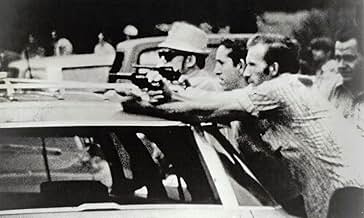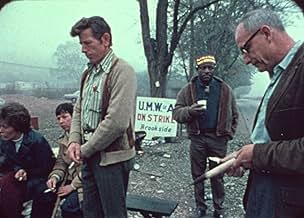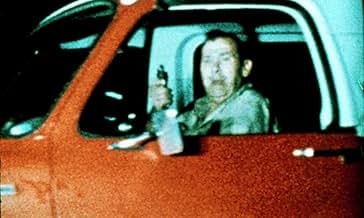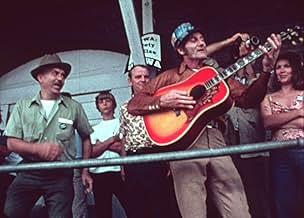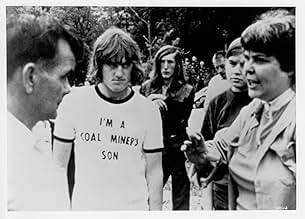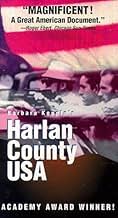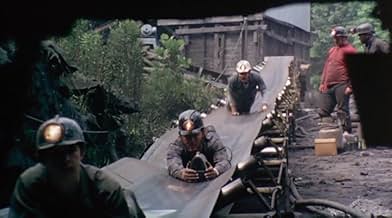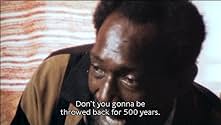Um registro comovente da luta de treze meses entre uma comunidade que luta para sobreviver e uma corporação dedicada aos resultados financeiros.Um registro comovente da luta de treze meses entre uma comunidade que luta para sobreviver e uma corporação dedicada aos resultados financeiros.Um registro comovente da luta de treze meses entre uma comunidade que luta para sobreviver e uma corporação dedicada aos resultados financeiros.
- Ganhou 1 Oscar
- 9 vitórias e 1 indicação no total
- Self - Pres., UMW, 1920-1960
- (cenas de arquivo)
- Self - Black Ling Clinic., W. Va
- (as Dr. Donald Rasmussen)
- Self
- (as Dr. Hawley Wells Jr.)
- Self - Pres., UMW, 1962-1972
- (cenas de arquivo)
- Self
- (cenas de arquivo)
- (as Joseph "Jock" Yablonski)
- Self - Mine Foreman
- (as Basil Collins)
Avaliações em destaque
It sometimes loses momentum as it documents the details of a particular labor strike in a mining town in rural Kentucky; yet that particular strike yields many memorable moments, including flashes of violence and revelatory dialogue. The company men are deliciously slick and slimy, and their goons are so ornery, that it's easy to forget that these people are real!
Where this film is at its best is where it uses historical footage and traditional labor songs to tie the strike to the larger past, and also where it explores other details of these people's lives -health issues, living conditions- that aren't specific to the strike. In this sense, the film becomes an important historical document of its own accord; unique, compelling, and enlightening to future generations.
This is a powerful Oscar-winning documentary produced and directed by Barbara Kopple ('American Dream', 'Wild Man Blues'). It focuses on the men at the Brookside Mine in Harlan, Kentucky who, in the summer of 1973, voted to join the United Mine Workers of America (UMWA). Duke Power Company and its subsidiary, Eastover Mining Company, refused to sign the contract. The miners came out on a long strike, registered by Kopple with testimonies, backstories, archival footage, and music, particularly that of Hazel Dickens during the final credits.
The film's main strength resides in the sincerity of its emotional, political and sociological core without being overtly sentimental, and Kopple's way of testifying instead of exploiting the subjects. The miners and their wives are not depicted in old hillbilly stereotypes, but rather as hard-working human beings fighting for their basic rights ('together we stand, divided we fall').
Thirty years after the release of this documentary, five miners died in an explosion at Harlan County. When the film was shot, money was the bigger issue (industry profits rose 170% in 1975, but miner's wages rose only 4%); nowadays, however, safety is an even bigger issue. You'd think things would have been largely improved since then, but that's not really the case. 'Harlan County U.S.A.' is a remarkable documentary because it testifies and proposes solutions about a public struggle that shouldn't be overlooked, yet has been for such a long time, in the "land of the free and home of the brave".
I used to consider Gates of Heaven and Harlan County USA as in deadlock for the best documentary ever made, but upon watching Harlan County USA again and all the extras available on the Criterion DVD, I have no choice but to move it into the sole number One position. The sense of dread and danger of Harlan County USA elevates it to a whole new level, making it perhaps the most watchable documentary ever made as well - its tense subject matter and the incredible footage captured by Kopple and her crew make it play as a feature film. Kopple's intimate participatory style makes the film even more poignant. The film crew was there with the strikers, amidst the bullets and beatings, at one point being singled out for attack and were beaten by the mining company militants. That they were there meant that they got some absolutely incredible footage, such as the scene described above, and when they catch the main strike breaker pointing his gun at them on film.
Harlan County USA is also an important social document, now housed in the national film registry for preservation. Scenes such as children being washed in buckets, in the 1970s, in the "beacon of freedom and democracy" The United States of America, really get beyond the rhetoric and show how the government and the big business agenda often trumps the rights of workers - its about maximizing profits not lives.
4/4
I guess it just goes to show how struggles with the cost of living aren't anything new, and this documentary does a great job of dispelling the idea that everyday people are greedy and want excessive amounts of money. I think most people are underpaid, and people just want the kind of compensation that will lower the stress of life. Bosses and people in charge always seem to hoard money. If this is the way things have to be run, then people who do hard work (and a lot of it) should be appropriately compensated. It's just a shame that some people view protests like this as radical or excessive, and I think a documentary like Harlan County USA could help change minds and attitudes.
Look, it's overall a very good documentary. The simple, natural style works. It's persuasive. Unions are good. I can't fault this stuff.
But this genuinely has one of the worst soundtracks I've ever heard, so uh, I'm sorry... points off for that (the god-awful music just never stops either).
Sure the documentary's one-sided since it shows the vibrant Appalachin coal-mining community struggling in the face of the coal company, strike-breakers, and law-enforcement allies. After all, I guess competing footage would have to be from a company executive session where profits and power are discussed, not indoor plumbing and a living wage. Clearly, the topic sorts itself for the average viewer.
Then there're the faces. You don't get life in the raw like this from a casting call on Hollywood and Vine. The men and women are indelible and a permanent record of the nation's real fabric. True, I don't have much ear for the down-home music that's such a strong narrative part, but I do have a new appreciation for what the artistry stands for. Thanks Barbara Koppel for going where movie-makers seldom go, and recording what many of us seldom see. Sure, that's been 40-years ago, but I dare say the lessons are as topical now as they were then. Maybe more so.
Você sabia?
- CuriosidadesWhen filming began, the film was intended to be about the 1972 campaign by Arnold Miller and Miners For Democracy to unseat UMWA president Tony Boyle, in the aftermath of Joseph Yablonski's murder; however, the Harlan County strike began and caused the filmmakers to change their principal subject, with the campaign and murder becoming secondary subjects.
- Citações
Hawley Wells Jr.: [...] that was when I learned my first real political lesson, about what happens when you take a position against the coal operators, against the capitalists... I found out that the union officials were working with the coal companies. I also found that the Catholic hierarchy was working with the coal companies. Here was a combination of the whole thing, you see: you had to bump against the whole combination of them.
- ConexõesFeatured in Cinéma Vérité: Defining the Moment (1999)
Principais escolhas
- How long is Harlan County U.S.A.?Fornecido pela Alexa
Detalhes
- Data de lançamento
- País de origem
- Central de atendimento oficial
- Idioma
- Também conhecido como
- Harlan County U.S.A.
- Locações de filme
- Empresa de produção
- Consulte mais créditos da empresa na IMDbPro
Contribua para esta página



